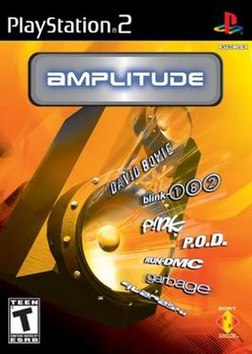Amplitude (video game)
| Amplitude | |
|---|---|
 |
|
| Developer(s) | Harmonix |
| Publisher(s) | Sony Computer Entertainment |
| Director(s) | Greg LoPiccolo |
| Producer(s) | Tracy Rosenthal-Newsom Daniel Sussman |
| Programmer(s) | Eran Egozy Eric Malafeew |
| Platform(s) | PlayStation 2 |
| Release | |
| Genre(s) | Music |
| Mode(s) | Single-player, Multiplayer |
Amplitude is a music video game developed by Harmonix for the PlayStation 2. It is the sequel to the previous game, Frequency. The game was released in North America on March 24, 2003 and in Europe on September 26, 2003.
In Amplitude the player controls a beat blaster ship across a lane of six tracks, each track representing a musical instrument and containing note gems that the player shoots at in time with the music. The player earns points for accurate playing and increases their scoring multiplier by playing a series of flawless sequences; the player loses energy by missing too many notes and can end the song prematurely if they run out of energy. Compared to the original Frequency which used more electronica and trance music, Amplitude included additional pop rock songs in its soundtrack.
The game was a critical but not a financial success, and would lead Harmonix to become a major studio in the development of music games. In 2014, Harmonix successfully offered a Kickstarter campaign to raise over $840,000 in funds to build a new Amplitude game for PlayStation 3 and 4 consoles; the remake was released in January 2016.
In Amplitude, the player controls a ship (referred to as a "Beat Blaster") moving down a path of varying shapes and lengths, containing up to six tracks. Each color-coded track corresponds to a different aspect of the song, such as percussion, synth, bass, or vocals, and contains a sequence of notes. As the player hits buttons corresponding to the note placement on the track, the notes activate a small portion of the track. If the player successfully activates enough notes in sequence, the track is "captured" and the section will play automatically for a number of bars, freeing the player to capture another section.
The object of the game is to capture a sufficient amount of sections to reach the end of the song. If the player continually misses notes, an energy meter empties until the game is over.
There are several different powerups available to the player to make gameplay easier. Powerups are gained by activating a series of specially shaped and colored notes. Such powerups allow immediate capturing of tracks, doubling of points scored, slowing down the speed of play, and jumping into freestyle mode (which allows the player to riff to the music, gaining points without the difficulty of playing predefined tracks).
...
Wikipedia
